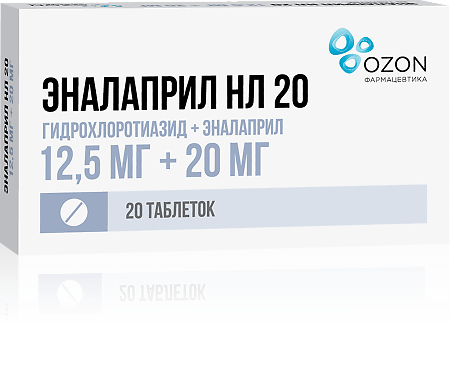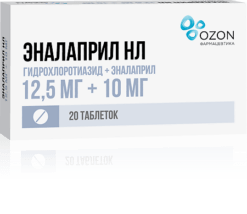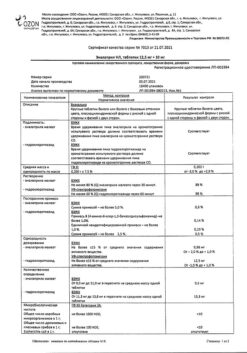No products in the cart.
Enalapril NL, tablets 12.5mg+20 mg 20 pcs
€6.66 €5.83
Description
Enalapril inhibits ACE, which promotes conversion of angiotensin I into angiotensin II, reduces the concentration of aldosterone in blood plasma, increases renin release, improves the functioning of kallikrein-kinin system, stimulates the release of prostaglandins and endothelial relaxing factor, inhibits sympathetic nervous system.
Taken together, these effects eliminate spasm and dilate peripheral arteries, reduce total peripheral vascular resistance, systolic and diastolic blood pressure (BP), post- and preload on the myocardium. It dilates arteries to a greater extent than veins, and there is no reflex increase in heart rate (HR).
The antihypertensive effect is more pronounced at high plasma renin concentration than at normal or reduced. Reduction of BP within therapeutic limits has no effect on the cerebral circulation. Improves blood supply to ischemic myocardium. Increases renal blood flow without changing glomerular filtration rate. In patients with initially decreased glomerular filtration its rate usually increases.
The maximum effect of enalapril develops after 6 – 8 hours and lasts up to 24 hours after oral administration. Hydrochlorothiazide is a thiazide diuretic of medium potency. It reduces the reabsorption of sodium ions at the level of the cortical segment of the loop of Genle without affecting its section in the medullary layer of the kidney.
Blocks carboanhydrase in the proximal part of the convoluted tubules, increases renal excretion of potassium ions, hydrocarbonates and phosphates. Practically does not affect the acid-base state. Increases the excretion of magnesium ions. Delays in the body calcium ions.
Diuretic effect develops after 1 – 2 hours, reaches a maximum after 4 hours, lasts for 10 – 12 hours. Its action decreases if glomerular filtration rate decreases and stops when its value is less than 30 ml/min. It decreases BP by decreasing the circulating blood volume (RBC) and changing the reactivity of the vascular wall.
The use of combination of Enalapril and hydrochlorothiazide leads to more significant decrease of BP in comparison with monotherapy by each of the drugs separately and allows to maintain antihypertensive effect of Enalapril H, Enalapril NL and Enalapril NL 20 at least for 24 h.
Indications
Indications
Arterial hypertension (patients who are indicated for combined therapy).
Active ingredient
Active ingredient
Composition
Composition
1 tablet contains the active ingredients:
enalapril maleate 20 mg and hydrochlorthiazide 12.5 mg;
Auxiliary substances:
Lactose 129.5 mg,
Microcrystalline cellulose 20 mg,
povidone 6 mg,
croscarmellose sodium 8 mg,
colloidal silicon dioxide 2 mg,
magnesium stearate 2 mg.
How to take, the dosage
How to take, the dosage
The treatment of arterial hypertension never begins with a combination of medications. Initially, adequate doses of the individual components must be determined. The dosage must always be chosen individually for each patient.
The usual dose is 1 tablet per day. Patients should take the tablets whole during or after meals, washed down with a small amount of liquid. They should get into the habit of taking the drug regularly at the same time, preferably in the morning. If a dose is missed, it should be taken as soon as possible if there is a long time before the next dose. If it is a few hours before the next dose, you should wait and take only the next dose. You should never double the dose.
If satisfactory therapeutic effect is not achieved, it is recommended that another medication be added or the therapy changed.
In patients on therapy with diuretics, it is recommended to cancel treatment or reduce the dose of diuretics at least 3 days before treatment with Enap-NL to prevent the development of symptomatic hypotension. Renal function should be investigated before starting treatment.
The duration of treatment is not limited.
Dosage in impaired renal function
Patients with a creatinine clearance greater than 0.5 mL/s or serum creatinine less than 265 mol/L (3 mg/100 mL) may be prescribed the usual dose of Enap-NL.
Interaction
Interaction
The simultaneous use of other antihypertensives, barbiturates, tricyclic antidepressants, phenothiazines and narcotic drugs, as well as alcohol intake, increases the antihypertensive effect of Enap-NL.
Analgesics and nonsteroidal anti-inflammatory drugs, a large amount of salt in the diet, concomitant administration of colestyramine or colestipol reduce the effect of Enap-NL. Concomitant use of Enap-NL and lithium drugs may lead to lithium intoxication, since enalapril and hydrochlorthiazide reduce lithium excretion. Serum lithium concentration should be monitored and its dosage adjusted accordingly. Concomitant treatment with Enap-NL and lithium preparations should be avoided if possible.
Concomitant use of Enap-NL and nonsteroidal anti-inflammatory drugs and analgesics (due to inhibition of prostaglandin synthesis) may decrease effectiveness of enalapril and increase risk of worsening of renal function and/or heart failure course. In some patients, concomitant treatment may also reduce the antihypertensive effect of enalapril, so patients should be closely monitored. Concomitant treatment with potassium-saving diuretics (spironolactone, amiloride, triamterene) or potassium supplementation may lead to hyperkalemia.
Simultaneous administration with allopurinol, cytostatics, immunosuppressants or systemic corticosteroids may cause leukopenia, anemia or pancytopenia, so periodic hemogram monitoring is required.
An acute renal failure has been reported in 2 patients after renal transplantation who simultaneously received enalapril and cyclosporine. Acute renal failure is thought to be the result of decreased renal blood flow caused by cyclosporine and decreased glomerular filtration caused by enalapril. Therefore, caution is required when using enalapril and cyclosporine concomitantly.
The concomitant administration of sulfonamide and oral hypoglycemic agents from the group of sulfonylureas may cause hypersensitivity reactions (cross-sensitization is possible).
Caution is required when concomitant use with cardiac glycosides. Possible hydrochlorothiazidine-induced hypovolemia, hypokalemia and hypomagnesemia may increase the toxicity of glycosides.
Concomitant administration with corticosteroids increases the risk of hypokalemia.
In concomitant use of Enap-NL and theophylline, enalapril may decrease the elimination half-life of theophylline.
With concomitant use of Enapa-NL and cimetidine, the elimination half-life of enalapril may be prolonged. The risk of arterial hypotension is increased during general anesthesia or the use of non-depolarizing myorelaxants (e.g., tubocurarin).
Special Instructions
Special Instructions
A pronounced decrease in BP with all clinical consequences may be observed after the first dose of Enap-NL tablets in patients with severe heart failure and hyponatremia, severe renal failure, arterial hypertension or left ventricular dysfunction and, especially, in patients who are hypovolemic as a result of diuretic therapy, salt-free diet, diarrhea, vomiting or hemodialysis. Arterial hypotension after the first dose and its more serious consequences are rare and passable. It can be avoided by withdrawing diuretics, if possible, before starting Enap-NL treatment.
In case of arterial hypotension, the patient should be placed on his back with a low headboard and, if necessary, plasma volume should be corrected by infusion of saline solution. Transient arterial hypotension is not a contraindication to continue treatment. After normalization of BP and replenishment of circulating blood volume, patients usually tolerate subsequent doses well. Caution is necessary when using in patients with impaired renal function (creatinine clearance of 0.5 to 1.3 ml/s). Patients taking hydrochlorothiazide may develop azotemia. In patients with impaired renal function there may be signs of accumulation of the drug. If necessary, a combination of enalapril with a lower amount of hydrochlorothiazide may be used or combined therapy with enalapril and hydrochlorothiazide should be canceled.
Enap-NL should be avoided in patients with bilateral renal artery stenosis or renal artery stenosis of the single kidney, as this may lead to worsening of renal function or even acute renal failure (enalapril effect). Therefore, renal function should be monitored before and during treatment with the drug.
Caution is required in patients with coronary heart disease, marked cerebrovascular disease, aortic stenosis or other stenosis preventing blood outflow from the left ventricle, marked atherosclerosis, in elderly patients due to the risk of arterial hypotension and worsened perfusion of the heart, brain and kidneys.
Regular monitoring of serum electrolyte concentrations during treatment is necessary in order to detect possible imbalances and take appropriate measures in time. Determination of serum electrolyte concentrations is mandatory for patients with prolonged diarrhea, vomiting and those receiving intravenous infusions. In patients taking Enap-NL it is necessary to actively detect signs of electrolyte imbalance such as dry mouth, thirst, weakness, drowsiness, lethargy, agitation, muscle pain and cramps (mainly calf muscles), decreased blood pressure, tachycardia, oliguria and gastrointestinal disorders (nausea, vomiting).
Enap-NL should be used with caution in patients with hepatic impairment or advanced liver disease because hydrochlorothiazide may cause hepatic coma even with minimal electrolyte disturbances.
During treatment with Enap-NL hypomagnesemia and sometimes hypercalcemia may occur as a result of increased magnesium excretion and delayed urinary calcium excretion under the influence of hydrochlorothiazide. Significant increase in serum calcium levels may be a sign of occult hyperparathyroidism. Hyperuricemia or worsening of the course of gout may be noted in some patients as a result of hydrochlorothiazide. If there is a rise in serum uric acid concentration, treatment should be discontinued. It can be resumed after normalization of laboratory indexes and further, be carried out under their control. Caution is necessary in all patients receiving treatment with oral hypoglycemic agents or insulin, as hydrochlorothiazide may weaken and enalapril may enhance their effects. Patients with diabetes mellitus should be monitored more frequently, and some change in the dose of hypoglycemic agents may be necessary. If angioedema of the face or neck occurs, withdrawal of therapy and administration of antihistamines is usually sufficient. In more severe cases (swelling of the tongue, pharynx and larynx), angioedema is treated with adrenaline, airway patency must be maintained (intubation or laryngotomy). The antihypertensive effect of Enapa NL may increase after sympathectomy. Due to increased risk of anaphylactic reactions, Enap-NL should not be administered to patients on hemodialysis with polyacrylonitrile membranes undergoing apheresis with dextransulfate and immediately before desensitization to wasp or bee venom, During Enap-NL treatment, hypersensitivity reactions may be noted in patients without previous allergy or bronchial asthma. Worsening of the course of systemic lupus erythematosus has been reported.
A few cases of acute hepatic failure with cholestatic jaundice, hepatic necrosis and death (rare) have been reported during treatment with ACE inhibitors. The cause of these syndromes is not completely clear. If jaundice and increased “liver” enzyme activity occur, treatment should be discontinued immediately and patients should be monitored.
Caution is also required in patients taking sulfonamides or oral hypoglycemic agents from the sulfonylurea group (cross-sensitization is possible).
With treatment, periodic monitoring of leukocyte count is required, especially in patients with connective tissue or renal diseases.
In patients after extensive surgery who have received drugs that cause arterial hypotension during general anesthesia, enalapril may block angiotensin II formation secondary to compensatory renin release. If the physician suggests this mechanism of arterial hypotension, treatment may be by increasing circulating blood volume. During treatment, periodic monitoring of serum concentrations of electrolytes, glucose, urea, creatinine and activity of “hepatic” enzymes, as well as urine protein is necessary. Treatment with Enap-NL should be discontinued before parathyroid function tests are performed.
Contraindications
Contraindications
With caution
Side effects
Side effects
General: weakness, hypersensitivity reactions (angioneurotic edema, thrombocytopenic purpura,) necrotizing angiitis, fever, respiratory distress, including pneumonitis and pulmonary edema, anaphylactic reactions.
Cardiovascular system disorders: palpitations, various heart rhythm disorders, marked BP decrease, orthostatic hypotension, cardiac arrest, myocardial infarction, cerebrovascular stroke, angina pectoris, Raynaud’s syndrome.
Gastrointestinal tract: dry mouth, glossitis, stomatitis, salivary gland inflammation, anorexia, nausea, vomiting, diarrhea, constipation, flatulence, epigastric pain, intestinal colic, ileus, pancreatitis, liver failure, hepatitis, jaundice, melena.
Respiratory system: rhinitis, sinusitis, pharyngitis, hoarseness, bronchospasm, asthma, pneumonia, pulmonary infiltrates, eosinophilic pneumonia, pulmonary embolism, pulmonary infarction, pulmonary edema.
Urogenital system: oliguria, gynecomastia, decreased potency, renal failure, renal dysfunction, interstitial nephritis.
Allergic reactions urticaria, itching.
Skin disorders: sweating, rash, exfoliative dermatitis, toxic epidermal necrolysis, erythema multiforme, Stephen-Johnson syndrome, shingles, alopecia, photosensitivity.
Senses: visual impairment, damage to taste, impaired sense of smell, tinnitus, conjunctivitis, dry conjunctivae, lacrimation.
From the central nervous system: depression, ataxia, somnolence, insomnia, anxiety, nervousness, peripheral neuropathy (paresthesias, dysesthesia).
Laboratory indicators: hypokalemia, hyperkalemia, hypomagnesemia, hypercalcemia, hyponatremia, hypochloremic alkalosis, hyperglycemia, glucosuria, hyperuricemia, hypercholesterolemia, hypertriglyceridemia, increased activity of liver enzymes, hyperbilirubinemia, leukocytosis, eosinophilia, neutropenia, leukopenia, agranulocytosis, anemia, hypoglobinemia, pancytopenia.
Others: lupus-like syndrome described in the literature (increased body temperature, myalgia and arthralgia, serositis, vasculitis, increased erythrocyte sedimentation rate, leukocytosis and eosinophilia, skin rash, positive antinuclear antibody test).
Overdose
Overdose
If a patient has taken too many tablets in one sitting, a physician should be called immediately. Symptoms of overdose: include increased diuresis, marked BP decrease with bradycardia or other heart rhythm disturbances, convulsions, paresis, paralytic ileus, disorders of consciousness (including coma), renal failure, acid-base balance disorder, blood electrolyte imbalance.
Treatment: the patient shall be placed in horizontal position with low head rest. In mild cases gastric lavage and oral intake of saline solution are indicated, in more serious cases – measures aimed at BP stabilization – intravenous infusion of physiological solution, plasma substitutes. The patient’s blood pressure, heart rate, respiration rate, serum concentrations of urea, creatinine, electrolytes, and urine output should be controlled, and if necessary – intravenous angiotensin II administration, hemodialysis (enalaprilat excretion rate – 62 ml/min).
Similarities
Similarities
Additional information
| Weight | 0.010 kg |
|---|---|
| Manufacturer | Ozon, Russia |
| Medication form | pills |
| Brand | Ozon |
Other forms…
Related products
Buy Enalapril NL, tablets 12.5mg+20 mg 20 pcs with delivery to USA, UK, Europe and over 120 other countries.

















